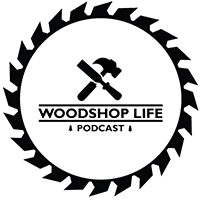This Episodes Questions:
Guys Questions:
Gentleman, Chris here @custom_by_chris on Instagram. My shop is a single car garage roughly 11.5’ wide by 22’ long. I’d like to build a miter station along the front wall for my Kapex. Will I regret confining myself to that 11.5’ width? I would position the saw so I have at least 8’ of cutting capacity to one side. I am not doing regular trim work so don’t frequently deal with long stock. Lastly, when designing and building the miter station what features would you consider must-haves or things that aren’t necessary? It’s easy to get sucked into the YouTube rabbit hole of miter stations so please guide me back to the light. Chris
Zach from Minnesota here. I recently constructed a box using box joints for the first time (thank you, I hold the applause.) As the tutorial by wood magazine suggested, I cut the fingers a little long with the intention of trimming them later rather than risking them being slightly too short. I have come across numerous suggestions regarding the best way to trim flush these protruding fingers, and as with most things to do with woodworking every suggested method also includes a comment claiming that following any of the other suggestions will ruin my work piece. What method do each of you prefer to use when flush trimming your box joints? Thanks in advance.
Sincerely, Zachary T Owens
Hi Guy and other guys,
Thanks for the great podcast. I have learned a lot from all the great content you put out. I really appreciate your advice and perspective. I have a couple questions I was hoping you could answer.
Recently I was rubbing a beeswax and tung oil finish on a little box I made for my mother in law. I was using a white scotch bright pad. I guess I didn’t softened one of the corners enough because the pad caught the grain and torn out a little piece of edge. My question is what do you do if something catastrophic happens while finishing? Do you sand it back repair it and then finish again? Do you have to sand the whole thing back or just the piece you are repairing? Or is there some trick to repairing finished wood? Or do you just trow it in the fireplace curse a lot and start over?
Thanks. Keep up the great work. Jon Moch
Huys Questions:
Hey guys, longtime follower and still enjoy listening to the podcast. Guy, it seems like you’ve fallen out of love with woodworking a bit and moved onto 3d printing? Is that just because you’ve been doing it forever haha? Always good to have a change.
I wanted to ask you guys about pigmented conversion varnish. I often hear you talk about it and I’ve never heard of it mentioned here in the uk across the pond, the only thing I can find online is it’s potentially the same as what we call acid catalyst? Is it dangerous to spray? Here in the UK acid catalyst (or commonly called AC) is quite toxic and you have to be in a proper booth with serious fume extraction and prober PPE respirator. Is this the same stuff? I’m guessing a pigmented conversion varnish would be a paint finish? Such as a solid colour? Any info would be great.
Keep up the great work guys, Mike
Hey guys thank you for all the information in the podcast and your previous answers to questions. For the most part I make sawdust. I build some furniture pieces, picture frames, boxes, etc. I also build some shipping crates for my real job which helps offset some of the cost of this hobby. The crates use 4×4, 2×8, 2×10 & 2×4 construction lumber and plywood. I’ve been using a sliding compound miter saw to cut up the boards. I’m reorganizing my garage and was thinking of selling the miter saw and going back to a Radial Arm Saw. I do not do any type of trim work or anything like that. Am I making a mistake wanting to go to the radial? It would just be for breaking down the boards to length. Thanks, Doug
Hi everyone,
Pretty much a novice woodworker with some questions on sapele. My primary question: I have a sapele front door that I inherited that has a finish that has not done well even in dappled sunlight. Fortunately, the door is completely structurally solid, so no repairs needed there. But my question is about how you would refinish it? I kind of like the look of a Danish oil or tung oil with a really solid coat of Total Boat marine finish to protect it. I have also seen people use Eipifanes as a protectant. But with little experience, I am guessing what the outcome will be. I would love to hear the team brainstorm what options I have to both enrich the beauty of the wood and the protect it. What should I optimally do to produce a nice piece that will last with regular care. Any suggestions on products?
More generally, we have some sapele accents in a refinished kitchen. Nothing too fancy or complicated – panhook bars and similar. I would like to build a few more simple pieces. Any thoughts on working with and finishing this type of wood from a broad perspective?
Great podcast. I love how you name brands and don’t beat around the bush on advice. As a “maybe I can do it someday” woodworker, I find each episode valuable! Thank you. George
